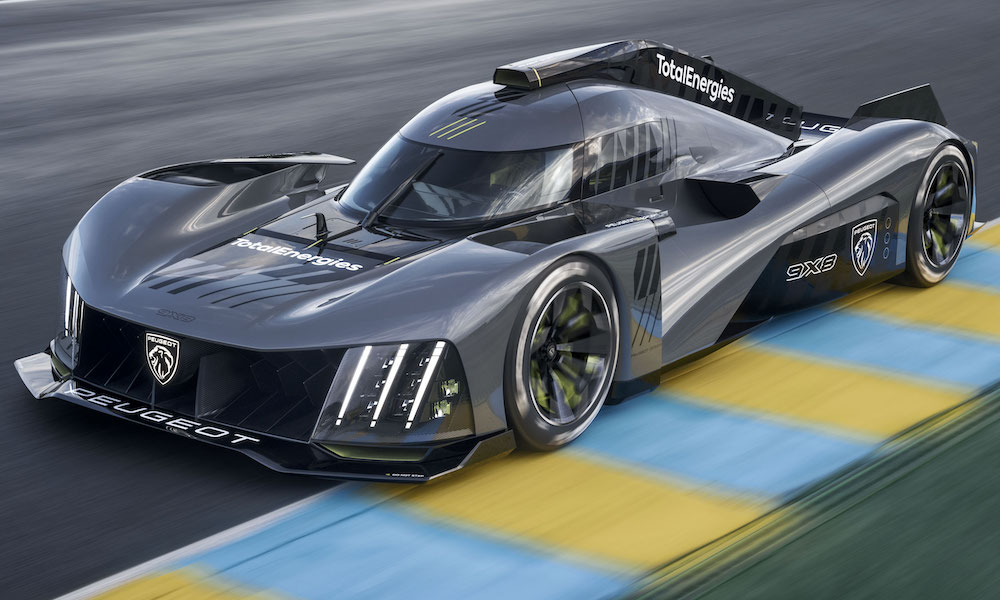The technical director of Peugeot’s LMH program says there is “no margin for error” in the 9X8’s powertrain testing schedule as preparations ramp up for a planned track debut by the end of this year.
Peugeot is currently running powertrain dynamometer tests for its new hybrid-powered prototype, which is due to race in the 2022 FIA World Endurance Championship season.
Technical director Olivier Jansonnie told Sportscar365 that the timing of Peugeot’s December rollout target has made for a busy and challenging pre-track testing phase, but the program remains on schedule.
Peugeot is due to take an “on time” delivery of its first monocoque for the 9X8 midway through next month. The car has been presented publicly in full-scale model form.
“The LMH is a completely new regulation and the time required for the pre-study was huge,” said Jansonnie.
“The pre-concept phase probably makes the difference for the next years.
“Then you have to compact your testing time to the minimum to try to arrive as early as possible on track. So it’s clear there’s no margin for error.
“We have been working on this kind of schedule for the last 18 months: it’s very, very tough. But since the beginning, we have said we will race in 2022.
“To achieve that there was no other solution, basically.”
Peugeot started its 9X8 powertrain testing process in March when it conducted the first dynamometer runs with the 500 kW, 2.6-liter twin-turbo V6 internal combustion engine.
It has since moved on to endurance internal combustion engine testing, which is an ongoing stage of the process. Peugeot will continue to add powertrain elements in the coming weeks, including the 200 kW electric motor, as it builds up the overall hybrid unit.
The so-called ‘Hybrid4′ powertrain will consist of an engine that automatically switches to a lower 300 kW output when the electric motor is in use above 120 km/h, to ensure the car’s overall output does not exceed the 500 kW maximum stated in the LMH rules.
The electric motor is the next part of the validation process and is set to begin testing imminently. Jansonnie noted that Peugeot is using “several engines” and “several dynos”.
“We have [made] evolutions to the engine already, which were planned,” said Jansonnie.
“We are assembling and testing. Now we are starting to assemble the front, so we are receiving the electrical engine and front gearbox, putting them together and testing them together. That’s the next stage.
“Once we do this, we will assemble the gearbox together with the engine and test on the rear powertrain dyno.
“And finally, a few weeks before we start running, we will put the four-wheel-drive system on.
“We are doing it piece after piece, testing each piece separately initially and then putting it together to start testing them as a whole.
“The enduro dyno test is not a complete run without stopping for a few days. Everything is new including the process, the rigs and the dynos. Everything is getting tested and getting up to speed.”
Peugeot is also working with TotalEnergies subsidiary Saft to develop a 900-volt battery that feeds the electric motor and is charged by a kinetic braking energy recovery system.
“Saft is working on the cells, so the cells are ready,” TotalEnergies motorsport technical coordinator Romain Aubry told Sportscar365.
“We are starting the production and now we have to finalize the Battery Management System which is co-designed by Peugeot Sport and TotalEnergies.
“We still have all the green lights so far. The development is going well and we are still on the schedule that we fixed with Peugeot two years ago.”
Peugeot plans to run the internal combustion engine and the front-mounted electric motor together on the dyno at the end of September or early October, according to Jean-Marc Finot who oversees the project as the Head of Stellantis Motorsport.
“Separately we are testing the ICE and the electric motor, and then after we test both of them on our dyno, our bench test,” he said.
“We do all the characterization, measurements and all checking on the bench in order to discover specific information or figures, due to the integration of the system in the car.
“For us it’s the best way to have a short time between the beginning of testing cars to reduce the time of the development program.
“If we have an issue and we have to redesign some parts, this is the reason why we can’t commit right now on the exact date when we will enter the championship.
“It’s due to the specificity of these regulations: as soon as the car is frozen it will be homologated for five years.”
The 2022 WEC season is due to start at Sebring International Raceway on March 18, while the 24 Hours of Le Mans is booked for June 11-12.
Jansonnie explained that dyno testing will continue right up to the moment that the 9X8 appears on track for the first time. The initial rollout is expected to take place in Europe.
“It will probably happen at the same time we begin running the test car,” said Jansonnie.
“Ideally you’re extending your powertrain test – of the whole powertrain and not just the engine – up to the point where you are actually [track] testing because you’re testing the whole system.
“You can actually do it with another engine and gearbox on your dyno as you begin your test car at the same time.”
Simulation testing is also continuing to take place in accordance with the seven contracted Peugeot drivers’ 2021 racing schedules.
























